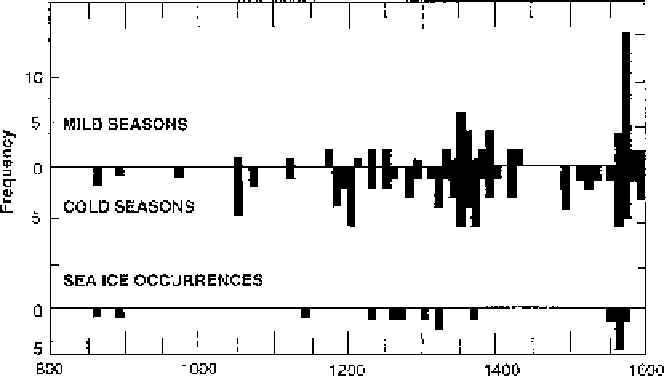Geoscience Reference
In-Depth Information
men and in ships. A considerable amount of colonial income was traded for
church construction material and trappings. At the height of colonial develop-
ment, churches were the largest structures, with bells, stained glass windows, the
finest wood, and other adornments similar to those in Europe.
8.2.4 Little Ice Age transition, 1250-1550
From about 1250 onwards in the North Atlantic region, a gradual cooling
became more evident, with greater fluctuations in seasonal weather and climate
from year to year and decade to decade (Figure
8.1
). A significant increase in the
number of cold seasons occurred (Figure
8.3
), interspersed with occasional mild
seasons, creating much higher variability in climate conditions then the previous
four centuries. Vail (
1998
) lists results from the Greenland Ice Project, which
show that cold years dominated in the periods 1308-18, 1324-9, 1343-62, and
1380-4, for example. Jensen et al.(
2004
) suggest that more stormy conditions
with increased winter wind speeds occurred in a stronger general circulation.
The Viking settlements at the heads of the fjords found little protection against
the increasingly harsh climate conditions.
Increases in sea ice and iceberg frequency occurred as well. Lamb (
1977
)
reports that sea ice appeared regularly off the coast of Iceland after 1002. The
warmer Atlantic waters were increasingly replaced by colder Arctic water from
the East Greenland current (Jensen et al.
2004
) along the coast and in the fjords
of Greenland.
The change in climate resulted in shorter summer growing seasons and consider-
ably longer, harsher winters. Heavier rainfall and colder temperatures interfered
with hay harvests, creating more winter seasons where animal starvation occurred.
The eventual drop in average temperature by 2-3 8C compared to the MWP
translated into a 50-60% loss in pasture productivity. Three to four centuries of
Figure 8.3 Occurrence
of milder or colder seasons,
and sea ice reports, from
Iceland between AD 800 and
1600. (From Ogilvie et al.
2000
)

Search WWH ::

Custom Search